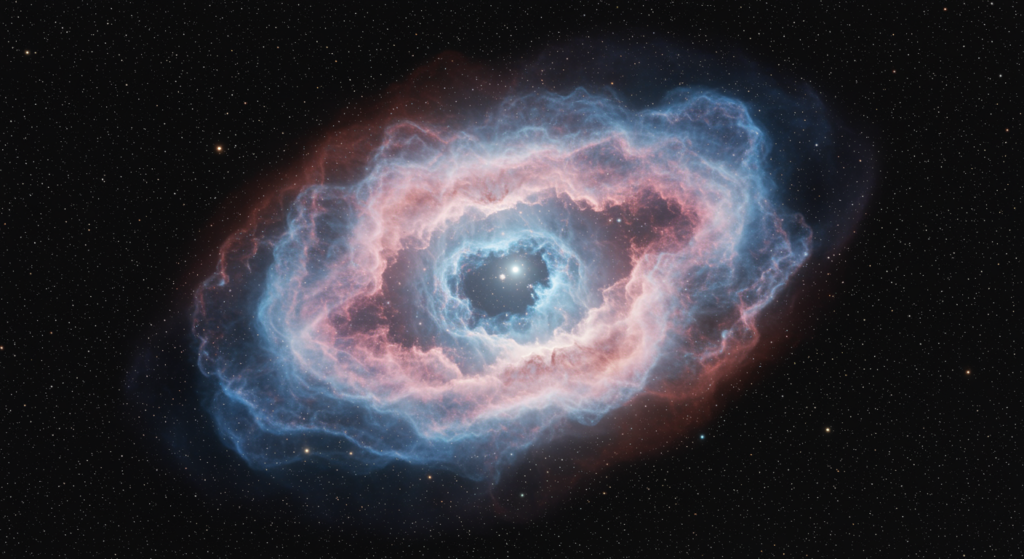
Glowing Hydrogen Blob Discovered Near Our Solar System
Unearthing the Eos Molecular Cloud in Our Cosmic Backyard
In a thrilling breakthrough for astronomy, researchers have uncovered a vast Eos molecular cloud, sitting just 300 light-years from Earth. This enormous structure, named after the Greek goddess of dawn, had eluded detection until now, offering fresh insights into the hidden wonders of our solar system’s surroundings. Imagine peering into space and finding a massive gas cloud that’s been right under our noses—this is exactly what scientists achieved with innovative techniques.
The announcement in late April 2025 highlights how the Eos molecular cloud is reshaping our knowledge of the interstellar medium and star formation processes. What makes this find so exciting is its close proximity, which lets us study these cosmic events like never before. Have you ever wondered what raw materials build stars? The Eos molecular cloud could hold some answers.
A Hidden Giant at the Edge of the Local Bubble
The Eos molecular cloud is a true behemoth, stretching across an area 40 times wider than the full moon in our sky. With a mass around 3,400 times that of our sun, it’s a prime example of how much unseen material floats in space. Led by astrophysicist Blakesley Burkhart from Rutgers University-New Brunswick, the team spotted this cloud using methods that went beyond the usual toolkit.
Situated on the boundary of the Local Bubble, the Eos molecular cloud is now recognized as the closest known structure of its kind to Earth. This discovery prompts us to rethink what we’ve assumed about our galactic neighborhood—after all, how many other surprises might be lurking nearby? It’s a reminder that space is full of mysteries waiting for the right tools to reveal them.
Why the Eos Molecular Cloud Stayed Under the Radar
Traditional searches for molecular clouds like the Eos molecular cloud rely on carbon monoxide as a marker, but this one has very little of it. That made it “CO-dark,” essentially invisible to standard observations until now. Burkhart’s team turned to far ultraviolet emissions from hydrogen molecules, a game-changer in detecting these elusive formations.
By analyzing data from the FIMS-SPEAR spectrograph on the Korean STSAT-1 satellite, they captured the faint glow of hydrogen in the Eos molecular cloud. This approach shows how blending technology and creativity can uncover what’s been hiding in plain sight. Isn’t it fascinating how a simple shift in perspective can transform our view of the universe?
Decoding the Glow: Innovative Detection of the Eos Molecular Cloud
Scientists detected the Eos molecular cloud by focusing on the far ultraviolet fluorescence of molecular hydrogen, a method that marks a first in astronomy. This glowing signature revealed a structure that traditional tools overlooked, emphasizing the need for diverse detection strategies. If you’re into space exploration, this technique could inspire new ways to hunt for similar clouds.
Burkhart described it as “the first-ever molecular cloud discovered by looking for far ultraviolet emission of molecular hydrogen directly.” The Eos molecular cloud’s glow in the dark offers a window into the interstellar medium’s complexities. For anyone curious about star formation, understanding this process might help us grasp how our own solar system came to be.
Overcoming the Challenges of CO-Dark Clouds
Most molecular clouds are identified through carbon monoxide, but the Eos molecular cloud bucks that trend with its minimal presence of this gas. This characteristic not only explains its elusiveness but also underscores the limitations of current methods. By adopting ultraviolet detection, researchers are paving the way for more comprehensive cosmic mapping—think of it as upgrading from a flashlight to a high-beam.
Moving forward, this discovery could lead to tools that reveal other hidden Eos molecular cloud-like structures. It’s a practical lesson: when one approach fails, innovation often succeeds, and that’s exactly what happened here.
Insights into Star Formation from the Eos Molecular Cloud
The Eos molecular cloud serves as a stellar nursery, packed with hydrogen gas and dust that fuel the birth of stars and planets. Its nearness to us—only 300 light-years—means we can observe these processes in unprecedented detail, almost like having a front-row seat. What if studying the Eos molecular cloud helped us unlock the secrets of how our sun formed?
Burkhart noted, “Our discovery of the Eos molecular cloud is exciting because we can now directly measure how molecular clouds form and dissociate.” This hands-on opportunity could answer key questions about galactic evolution. For enthusiasts, it’s a chance to see the building blocks of the universe at work.
A Time-Sensitive Cosmic Laboratory
Experts predict the Eos molecular cloud will dissipate in about 6 million years, giving us a limited timeframe to gather data. This urgency adds excitement to the research, as every observation counts in piecing together the life cycle of such clouds. If you’re tracking space news, keep an eye on how this timeline influences ongoing studies.
By examining the Eos molecular cloud, scientists aim to clarify the steps from gas clouds to fully formed stars. It’s like watching a time-lapse of creation, offering tips for future explorations and even hypothetical scenarios for planet formation in our own backyard.
Broader Implications: Searching Beyond the Eos Molecular Cloud
The Eos molecular cloud’s discovery is sparking a wider hunt for similar hydrogen-rich structures across the galaxy. Teams are now using tools like the James Webb Space Telescope to probe distant regions, potentially identifying the farthest molecular clouds yet. This could bookend our understanding, from the closest Eos molecular cloud to cosmic frontiers.
These efforts highlight how new techniques are reshaping astronomy, revealing layers of the universe we’ve barely scratched. As a result, our map of the interstellar medium is getting more detailed, which might inspire you to dive deeper into stargazing or related science.
Unveiling More Hidden Structures Through Advanced Methods
Innovations that worked for the Eos molecular cloud are being applied elsewhere, promising to uncover more undetected cosmic features. This shift away from carbon monoxide detection could lead to a boom in discoveries, much like how explorers once charted unknown lands. If you’re interested in astronomy, consider how these methods might evolve into everyday tools for observation.
The payoff? A clearer picture of star-forming materials and their distribution, which enhances our grasp of galactic dynamics. It’s an actionable reminder to stay curious and support advancing tech in this field.
Addressing Potential Concerns About the Eos Molecular Cloud
While the Eos molecular cloud is massive and nearby, there’s no need for alarm—it’s completely harmless to Earth and our solar system. At 300 light-years away, that’s over 1.8 quadrillion miles, far beyond any influence on us. This discovery is all about scientific enrichment, not threats.
Scientists stress that the Eos molecular cloud offers pure research value, letting us study interstellar phenomena safely from afar. So, next time you look at the night sky, you can appreciate it as a distant, glowing curiosity rather than a worry.
What’s Next in Eos Molecular Cloud Research?
With the Eos molecular cloud in focus, astronomers are gearing up for deeper analyses of its makeup, movements, and evolution. This could reveal the precise conditions that spark star formation, building on what we’ve learned so far. If you enjoy science, tracking these developments might offer some engaging insights into our universe’s mechanics.
Embracing a New Era of Discovery
This find with the Eos molecular cloud illustrates that even well-explored areas of space hold surprises, thanks to fresh techniques. It’s motivating for the field, potentially leading to a revolution in how we detect and study cosmic elements. Consider it a call to action: share your thoughts on what this might mean for future space missions.
As research progresses, we could gain strategies for identifying similar clouds, making astronomy more accessible and exciting for everyone. What are your ideas on how this could impact our understanding of the cosmos?
Wrapping Up: The Legacy of the Eos Molecular Cloud
The Eos molecular cloud stands out as a pivotal discovery, blending proximity, scale, and novelty in ways that advance our knowledge of the interstellar medium. By studying its glowing hydrogen, we’re getting closer to deciphering the origins of stars and planets, right in our cosmic vicinity.
This isn’t just about one cloud—it’s about opening doors to broader explorations. We invite you to share your reactions in the comments, explore more on our site, or spread the word about this fascinating find. Let’s keep the conversation going—what excites you most about the Eos molecular cloud?
References
1. Rutgers University. “Vast Molecular Cloud, Long Invisible, Discovered Near Solar System.” Rutgers.edu
2. NYU. “Long-Invisible Molecular Cloud Discovered Near Our Solar System.” NYU.edu
3. ScienceBlog. “Giant Invisible Cloud Discovered Near Earth.” ScienceBlog.com
4. The Tribune. “Scientists Discover Massive Hidden Molecular Cloud Near Earth.” Tribune.com.pk
5. Courthouse News Service. “Massive Glow-in-the-Dark Cloud of Star-Forming Gas Found Hiding Near Solar System.” Courthousenews.com
Eos molecular cloud, hydrogen molecules, solar system discovery, ultraviolet emission, interstellar medium, star formation, molecular cloud discovery, cosmic structures, galactic evolution, astronomical breakthroughs







